文章目录
第一部分
引入
构建您的深度神经网络:循序渐进
欢迎来到您的第 4 周作业(第 1 部分,共 2 部分)! 您之前已经训练了一个 2 层神经网络(具有单个隐藏层)。 本周,您将构建一个深度神经网络,层数不限!
- 在本笔记本中,您将实现构建深度神经网络所需的所有功能。
- 在下一个作业中,您将使用这些函数来构建用于图像分类的深度神经网络。
完成此任务后,您将能够:
- 使用像 ReLU 这样的非线性单元来改进你的模型
- 构建更深的神经网络(具有 1 个以上的隐藏层)
- 实现一个易于使用的神经网络类
Notation:
- 上标
[
l
]
[l]
[l] 表示与
l
t
h
l^{th}
lth 层相关的数量.
- 举例: a [ L ] a^{[L]} a[L] 是第 L t h L^{th} Lth 层的激活. W [ L ] W^{[L]} W[L] 和 b [ L ] b^{[L]} b[L] 是第 L t h L^{th} Lth层的参数.
- 上标
(
i
)
(i)
(i) 表示与第
i
t
h
i^{th}
ith 样本相关的数量.
- 举例: x ( i ) x^{(i)} x(i) 是第 i t h i^{th} ith 个训练样本.
- 下标
i
i
i表示向量的第
i
t
h
i^{th}
ith 项.
- 举例: a i [ l ] a^{[l]}_i ai[l]? 表示第 l t h l^{th} lth层激活的第 i t h i^{th} ith项.
让我们开始吧!
1 - 导入所需包
让我们首先导入您在此任务中需要的所有包。
- numpy 是使用 Python 进行科学计算的主要包。
- matplotlib 是一个用 Python 绘制图形的库。
- dnn_utils 为这个笔记本提供了一些必要的功能。
- testCases 提供了一些测试用例来评估你的函数的正确性
- np.random.seed(1) 用于保持所有随机函数调用的一致性。 它将帮助我们为您的工作评分。 请不要改变种子。
import numpy as np
import h5py
import matplotlib.pyplot as plt
from testCases_v2 import *
from dnn_utils_v2 import sigmoid, sigmoid_backward, relu, relu_backward
%matplotlib inline
plt.rcParams['figure.figsize'] = (5.0, 4.0) # 设置图的默认大小
plt.rcParams['image.interpolation'] = 'nearest'
plt.rcParams['image.cmap'] = 'gray'
%load_ext autoreload
%autoreload 2
np.random.seed(1)
2 - 作业大纲
要构建您的神经网络,您将实现几个“辅助函数”。 这些辅助函数将在下一个作业中用于构建两层神经网络和 L 层神经网络。 您将实现的每个小辅助函数都有详细的说明,将引导您完成必要的步骤。 这是此作业的大纲,您将:
- 初始化两层网络和 𝐿 层神经网络的参数。
- 实现前向传播模块(下图中紫色部分)。
- 完成层前向传播步骤的 LINEAR 部分(产生 𝑍[𝑙])。
- 我们为您提供 ACTIVATION 函数(relu/sigmoid)。
- 将前两步组合成一个新的[LINEAR->ACTIVATION]前向函数。
- 堆叠 [LINEAR->RELU] 前向函数 L-1 次(对于第 1 层到 L-1 层)并在末尾添加 [LINEAR->SIGMOID](对于最后一层 𝐿)。 这为您提供了一个新的 L_model_forward 函数。
- 计算损失。
- 实现反向传播模块(下图中用红色表示)。
- 完成层的反向传播步骤的 LINEAR 部分。
- 我们给你ACTIVATE函数的梯度(relu_backward/sigmoid_backward)
- 将前面的两步合并成一个新的[LINEAR->ACTIVATION]向后函数。
- 将 [LINEAR->RELU] 向后堆叠 L-1 次并在新的 L_model_backward 函数中向后添加
[LINEAR->SIGMOID]
- 最后更新参数。
请注意,对于每个前向函数,都有一个相应的后向函数。 这就是为什么在转发模块的每一步你都会在缓存中存储一??些值。 缓存值可用于计算梯度。 在反向传播模块中,您将使用缓存来计算梯度。 此作业将准确地向您展示如何执行每个步骤。
3 - 初始化
您将编写两个辅助函数来初始化模型的参数。 第一个函数将用于初始化两层模型的参数。 第二个将把这个初始化过程推广到 𝐿L 层。
3.1 - 2 层神经网络
【练习】:创建并初始化 2 层神经网络的参数。
【指示】:
模型的结构是:LINEAR -> RELU -> LINEAR -> SIGMOID。
对权重矩阵使用随机初始化。 使用具有正确形状的 np.random.randn(shape)*0.01 。
对偏差使用零初始化。 使用 np.zeros(shape)。
# GRADED FUNCTION: initialize_parameters
def initialize_parameters(n_x, n_h, n_y):
"""
初始化2层神经网络的参数
参数:
n_x -- 输入层大小
n_h -- 隐藏层大小
n_y -- 输出层大小
返回:
parameters -- 包含参数的Python字典:
W1 -- 形状为(n_h, n_x)的权重矩阵
b1 -- 形状为(n_h, 1)的偏差向量
W2 -- 形状为(n_y, n_h)的权重矩阵
b2 -- 形状为(n_y, 1)的偏差向量
"""
np.random.seed(1)
### START CODE HERE ### (≈ 4 lines of code)
W1 = np.random.randn(n_h, n_x) *0.01
b1 = np.zeros((n_h, 1))
W2 = np.random.randn(n_y, n_h) *0.01
b2 = np.zeros((n_y, 1))
### END CODE HERE ###
assert(W1.shape == (n_h, n_x))
assert(b1.shape == (n_h, 1))
assert(W2.shape == (n_y, n_h))
assert(b2.shape == (n_y, 1))
parameters = {"W1": W1,
"b1": b1,
"W2": W2,
"b2": b2}
return parameters
parameters = initialize_parameters(2,2,1)
print("W1 = " + str(parameters["W1"]))
print("b1 = " + str(parameters["b1"]))
print("W2 = " + str(parameters["W2"]))
print("b2 = " + str(parameters["b2"]))
输出结果为
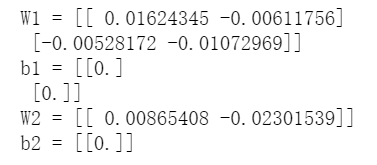
3.2 - L 层神经网络
更深的 L 层神经网络的初始化更加复杂,因为有更多的权重矩阵和偏置向量。 完成 initialize_parameters_deep 时,您应该确保每个层之间的尺寸匹配。 回想一下 𝑛[𝑙]是层 𝑙中的单元数。
例如:如果我们的输入 𝑋的大小是 (12288,209)(有 𝑚=209个例子),那么:
执行一下如下的代码:
<!-- 按照作业的代码稍微改了一下,不然显示不出来东西,
不太会html语言,轻喷= = -->
<html>
<body>
<table border="1">
<tr>
<td> </td>
<td> **Shape of W** </td>
<td> **Shape of b** </td>
<td> **Activation** </td>
<td> **Shape of Activation** </td>
<tr>
<tr>
<td> **Layer 1** </td>
<td> $( n^{[1]}, 12288)$ </td>
<td> $(n^{[1]},1)$ </td>
<td> $Z^{[1]} = W^{[1]} X + b^{[1]} $ </td>
<td> $(n^{[1]},209)$ </td>
<tr>
<tr>
<td> **Layer 2** </td>
<td> $(n^{[2]}, n^{[1]})$ </td>
<td> $(n^{[2]},1)$ </td>
<td>$Z^{[2]} = W^{[2]} A^{[1]} + b^{[2]}$ </td>
<td> $(n^{[2]}, 209)$ </td>
<tr>
<tr>
<td> $\vdots$ </td>
<td> $\vdots$ </td>
<td> $\vdots$ </td>
<td> $\vdots$</td>
<td> $\vdots$ </td>
<tr>
<tr>
<td> **Layer L-1** </td>
<td> $(n^{[L-1]}, n^{[L-2]})$ </td>
<td> $(n^{[L-1]}, 1)$ </td>
<td>$Z^{[L-1]} = W^{[L-1]} A^{[L-2]} + b^{[L-1]}$ </td>
<td> $(n^{[L-1]}, 209)$ </td>
<tr>
<tr>
<td> **Layer L** </td>
<td> $(n^{[L]}, n^{[L-1]})$ </td>
<td> $(n^{[L]}, 1)$ </td>
<td> $Z^{[L]} = W^{[L]} A^{[L-1]} + b^{[L]}$</td>
<td> $(n^{[L]}, 209)$ </td>
<tr>
</table>
</body>
</html>
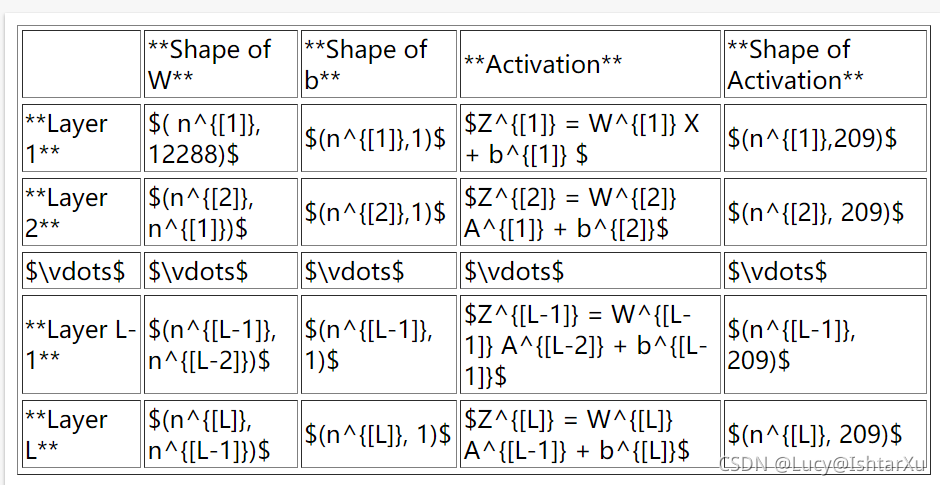
请记住,当我们在python中计算𝑊𝑋+𝑏时,它进行广播。 例如,如果:
W
=
[
j
k
l
m
n
o
p
q
r
]
??????
X
=
[
a
b
c
d
e
f
g
h
i
]
??????
b
=
[
s
t
u
]
(2)
W = \begin{bmatrix} j & k & l\\ m & n & o \\ p & q & r \end{bmatrix}\;\;\; X = \begin{bmatrix} a & b & c\\ d & e & f \\ g & h & i \end{bmatrix} \;\;\; b =\begin{bmatrix} s \\ t \\ u \end{bmatrix}\tag{2}
W=???jmp?knq?lor????X=???adg?beh?cfi????b=???stu????(2)
则𝑊𝑋+𝑏为
W
X
+
b
=
[
(
j
a
+
k
d
+
l
g
)
+
s
(
j
b
+
k
e
+
l
h
)
+
s
(
j
c
+
k
f
+
l
i
)
+
s
(
m
a
+
n
d
+
o
g
)
+
t
(
m
b
+
n
e
+
o
h
)
+
t
(
m
c
+
n
f
+
o
i
)
+
t
(
p
a
+
q
d
+
r
g
)
+
u
(
p
b
+
q
e
+
r
h
)
+
u
(
p
c
+
q
f
+
r
i
)
+
u
]
(3)
WX + b = \begin{bmatrix} (ja + kd + lg) + s & (jb + ke + lh) + s & (jc + kf + li)+ s\\ (ma + nd + og) + t & (mb + ne + oh) + t & (mc + nf + oi) + t\\ (pa + qd + rg) + u & (pb + qe + rh) + u & (pc + qf + ri)+ u \end{bmatrix}\tag{3}
WX+b=???(ja+kd+lg)+s(ma+nd+og)+t(pa+qd+rg)+u?(jb+ke+lh)+s(mb+ne+oh)+t(pb+qe+rh)+u?(jc+kf+li)+s(mc+nf+oi)+t(pc+qf+ri)+u????(3)
【练习】:实现 L 层神经网络的初始化。
【指示】:
-
模型的结构是
*[LINEAR -> RELU] ×× (L-1) -> LINEAR -> SIGMOID*。 即,它具有使用
ReLU 激活函数的 𝐿?1 层,后跟具有 sigmoid 激活函数的输出层。 -
对权重矩阵使用随机初始化。 使用
np.random.rand(shape) * 0.01。 -
对偏差使用零初始化。 使用
np.zeros(shape)。 -
我们将在变量
layer_dims中存储𝑛[𝑙],不同层中的单元数。 例如,上周的“平面数据分类模型”的
layer_dims 应该是 [2,4,1]:有2个输入,一个带有 4 个隐藏单元的隐藏层,一个带有 1
个输出单元的输出层。 因此意味着 W1 的形状是 (4,2),b1 是 (4,1),W2 是 (1,4),b2 是 (1,1)。
现在你将把它推广到 𝐿层! -
这是𝐿=1(一层神经网络)的实现。 它应该激励您实现一般情况(L 层神经网络)。
if L == 1:
parameters["W" + str(L)] = np.random.randn(layer_dims[1], layer_dims[0]) * 0.01
parameters["b" + str(L)] = np.zeros((layer_dims[1], 1))
# GRADED FUNCTION: initialize_parameters_deep
def initialize_parameters_deep(layer_dims):
"""
初始化深层神经网络参数
参数:
layer_dims -- python数组(列表)包含我们网络中每一层的维度
Returns:
parameters -- 包含参数 "W1", "b1", ..., "WL", "bL"的python字典:
Wl -- 形状为 (layer_dims[l], layer_dims[l-1])的权重矩阵
bl -- 形状为 (layer_dims[l], 1)的偏差矩阵
"""
np.random.seed(3)
parameters = {}
L = len(layer_dims) # 网络的层数
for l in range(1, L):
### START CODE HERE ### (≈ 2 lines of code)
parameters['W' + str(l)] = np.random.randn(layer_dims[l], layer_dims[l-1])*0.01
parameters['b' + str(l)] = np.zeros((layer_dims[l], 1))
### END CODE HERE ###
assert(parameters['W' + str(l)].shape == (layer_dims[l], layer_dims[l-1]))
assert(parameters['b' + str(l)].shape == (layer_dims[l], 1))
return parameters
测试代码
parameters = initialize_parameters_deep([5,4,3])
print("W1 = " + str(parameters["W1"]))
print("b1 = " + str(parameters["b1"]))
print("W2 = " + str(parameters["W2"]))
print("b2 = " + str(parameters["b2"]))
输出结果为
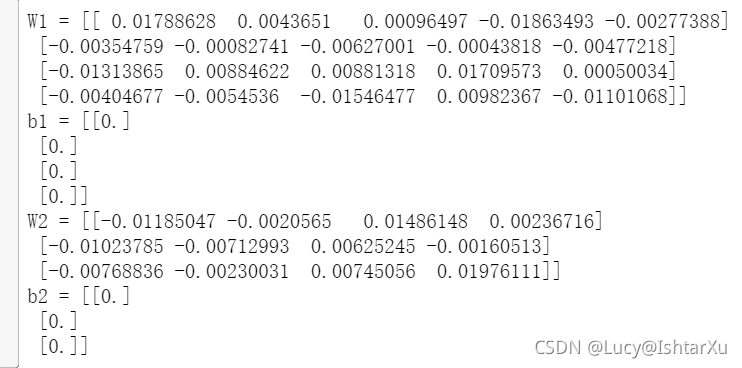
4 - 前向传播模块
4.1 - 线性前向
现在您已经初始化了您的参数,您将执行前向传播模块。 您将从实现一些基本功能开始,稍后您将在实现模型时使用这些功能。 您将按此顺序完成三个功能:
- 线性
- LINEAR -> ACTIVATION 其中 ACTIVATION 将是 ReLU 或 Sigmoid。
- [LINEAR -> RELU] ×× (L-1) -> LINEAR -> SIGMOID(全模型)
线性前向模块(对所有样本进行矢量化)计算以下等式:
Z
[
l
]
=
W
[
l
]
A
[
l
?
1
]
+
b
[
l
]
(4)
Z^{[l]} = W^{[l]}A^{[l-1]} +b^{[l]}\tag{4}
Z[l]=W[l]A[l?1]+b[l](4)
其中 A [ 0 ] = X A^{[0]} = X A[0]=X.
【练习】:构建前向传播的线性部分。
【提醒】:这个单位的数学表示是
Z
[
l
]
=
W
[
l
]
A
[
l
?
1
]
+
b
[
l
]
Z^{[l]} = W^{[l]}A^{[l-1]} +b^{[l]}
Z[l]=W[l]A[l?1]+b[l]。 您可能还会发现 np.dot() 很有用。 如果您的尺寸不匹配,打印 W.shape 可能会有所帮助。
# GRADED FUNCTION: linear_forward
def linear_forward(A, W, b):
"""
实现一层前向传播的线性部分.
参数:
A -- 来自前一层(或输入数据)的激活:(前一层的大小,样本数)
W -- 权重矩阵:形状为(当前层的大小,前一层的大小)的 numpy 数组
b -- 偏置向量,形状为(当前层的大小,1)的 numpy 数组
返回:
Z -- 激活函数的输入,也称为预激活参数
cache -- 包含“A”、“W”和“b”的python字典; 存储以有效计算反向传播
"""
### START CODE HERE ### (≈ 1 line of code)
Z = np.dot(W,A) + b
### END CODE HERE ###
assert(Z.shape == (W.shape[0], A.shape[1]))
cache = (A, W, b)
return Z, cache
测试代码
A, W, b = linear_forward_test_case()
Z, linear_cache = linear_forward(A, W, b)
print("Z = " + str(Z))
输出结果为

4.2 - 线性激活前向
在本笔记本中,您将使用两个激活函数:
Sigmoid:
σ
(
Z
)
=
σ
(
W
A
+
b
)
=
1
1
+
e
?
(
W
A
+
b
)
\sigma(Z) = \sigma(W A + b) = \frac{1}{ 1 + e^{-(W A + b)}}
σ(Z)=σ(WA+b)=1+e?(WA+b)1?。
我们已经为您提供了 sigmoid 函数。 该函数返回两项:激活值“a”和包含“Z”的“缓存”(这是我们将提供给相应的反向函数的内容)。 要使用它,您只需调用:
A、activation_cache = sigmoid(Z)
ReLU:ReLu 的数学公式是
A
=
R
E
L
U
(
Z
)
=
m
a
x
(
0
,
Z
)
A = RELU(Z) = max(0, Z)
A=RELU(Z)=max(0,Z)。 我们已经为您提供了 relu 功能。
该函数返回两项:激活值“A”和包含“Z”的“缓存”(这是我们将提供给相应的反向函数的内容)。 要使用它,您只需调用:
A、activation_cache = relu(Z)
为方便起见,您将把两个函数(线性和激活)归为一个函数(线性->激活)。 因此,您将实现一个函数,该函数执行 LINEAR 前向步骤,然后是 ACTIVATION 前向步骤。
【练习】:实现 LINEAR->ACTIVATION 层的前向传播。
数学关系为:
A
[
l
]
=
g
(
Z
[
l
]
)
=
g
(
W
[
l
]
A
[
l
?
1
]
+
b
[
l
]
)
A^{[l]} = g(Z^{[l]}) = g(W^{[l]}A^{[l-1]} +b^{[l]})
A[l]=g(Z[l])=g(W[l]A[l?1]+b[l])其中激活“g”可以是 sigmoid() 或 relu()。 使用 linear_forward() 和正确的激活函数。
# GRADED FUNCTION: linear_activation_forward
def linear_activation_forward(A_prev, W, b, activation):
"""
实现 LINEAR->ACTIVATION 层的前向传播
参数:
A_prev -- 来自前一层(或输入数据)的激活:(前一层的大小,样本数)
W -- 权重矩阵:形状为(当前层的大小,前一层的大小)的numpy 数组
b -- 偏置向量,形状为(当前层的大小,1)的 numpy 数组
activation -- 在该层中使用的激活,存储为文本字符串:“sigmoid”或“relu”
返回:
A -- 激活函数的输出,也称为激活后值
cache -- 包含“linear_cache”和“activation_cache”的python字典;
存储以有效计算反向传播
"""
if activation == "sigmoid":
# 输入: "A_prev, W, b". 输出: "A, activation_cache".
### START CODE HERE ### (≈ 2 lines of code)
Z, linear_cache = linear_forward(A_prev, W, b)
A, activation_cache = sigmoid(Z)
### END CODE HERE ###
elif activation == "relu":
# 输入: "A_prev, W, b". 输出: "A, activation_cache".
### START CODE HERE ### (≈ 2 lines of code)
Z, linear_cache = linear_forward(A_prev, W, b)
A, activation_cache = relu(Z)
### END CODE HERE ###
assert (A.shape == (W.shape[0], A_prev.shape[1]))
cache = (linear_cache, activation_cache)
return A, cache
测试代码
A_prev, W, b = linear_activation_forward_test_case()
A, linear_activation_cache = linear_activation_forward(A_prev, W, b, activation = "sigmoid")
print("With sigmoid: A = " + str(A))
A, linear_activation_cache = linear_activation_forward(A_prev, W, b, activation = "relu")
print("With ReLU: A = " + str(A))
输出结果为

【注意】:在深度学习中,“[LINEAR->ACTIVATION]”计算在神经网络中算作单层,而不是两层。
4.3 - L 层模型
为了在实现 𝐿 层神经网络时更加方便,您将需要一个函数来复制前一个函数(linear_activation_forward 和 RELU)𝐿?1次,然后是一个带有 SIGMOID 的 linear_activation_forward。

【练习】:实现上述模型的前向传播。
说明:在下面的代码中,变量AL表示
A
[
L
]
=
σ
(
Z
[
L
]
)
=
σ
(
W
[
L
]
A
[
L
?
1
]
+
b
[
L
]
)
A^{[L]} = \sigma(Z^{[L]}) = \sigma(W^{[L]} A^{[L-1]} + b^{[L]})
A[L]=σ(Z[L])=σ(W[L]A[L?1]+b[L]) (这有时也称为 Yhat,即这是 𝑌?。)
【提示】:
- 使用您之前编写的函数
- 使用 for 循环复制 [LINEAR->RELU] (L-1) 次
- 不要忘记跟踪“缓存”列表中的缓存。 要将新值 c 添加到列表中,您可以使用
list.append(c)
# GRADED FUNCTION: L_model_forward
def L_model_forward(X, parameters):
"""
为 [LINEAR->RELU]*(L-1)->LINEAR->SIGMOID 计算实现前向传播
参数:
X -- data, numpy数组形状为 (输入大小, 样本数)
parameters -- initialize_parameters_deep()的输出
返回:
AL -- 上次激活后的值
caches -- 缓存列表包含:
linear_relu_forward() 的每个缓存
(其中有 L-1 个,索引从 0 到 L-2)
linear_sigmoid_forward()的缓存
(有一个,索引为 L-1)
"""
caches = []
A = X
L = len(parameters) // 2 # 神经网络的层数
# 实现 [LINEAR -> RELU]*(L-1)。 将“缓存”添加到“缓存”列表中
for l in range(1, L):
A_prev = A
### START CODE HERE ### (≈ 2 lines of code)
A, cache = linear_activation_forward(A, parameters['W' + str(l)], parameters['b' + str(l)], activation = 'relu')
caches.append(cache)
### END CODE HERE ###
# 实现 LINEAR -> SIGMOID。 将“缓存”添加到“缓存”列表中。.
### START CODE HERE ### (≈ 2 lines of code)
AL, cache = linear_activation_forward(A, parameters['W' + str(L)], parameters['b' + str(L)], activation = 'sigmoid')
### END CODE HERE ###
assert(AL.shape == (1,X.shape[1]))
return AL, caches
测试代码
X, parameters = L_model_forward_test_case()
AL, caches = L_model_forward(X, parameters)
print("AL = " + str(AL))
print("Length of caches list = " + str(len(caches)))
输出结果为

非常好! 现在你有了一个完整的前向传播,它接受输入 X 并输出一个包含你的预测的行向量 𝐴[𝐿]。 它还在“缓存”中记录所有中间值。 使用 𝐴[𝐿] ,您可以计算预测的成本。
5 - 成本函数
现在您将实现前向和后向传播。 您需要计算成本,因为您想检查您的模型是否真的在学习。
【练习】:使用以下公式计算交叉熵成本 𝐽 :
?
1
m
∑
i
=
1
m
(
y
(
i
)
log
?
(
a
[
L
]
(
i
)
)
+
(
1
?
y
(
i
)
)
log
?
(
1
?
a
[
L
]
(
i
)
)
)
(7)
-\frac{1}{m} \sum\limits_{i = 1}^{m} (y^{(i)}\log\left(a^{[L] (i)}\right) + (1-y^{(i)})\log\left(1- a^{[L](i)}\right)) \tag{7}
?m1?i=1∑m?(y(i)log(a[L](i))+(1?y(i))log(1?a[L](i)))(7)
# GRADED FUNCTION: compute_cost
def compute_cost(AL, Y):
"""
实现等式(7)定义的成本函数
参数:
AL -- 对应于您的标签预测的概率向量, 大小为 (1, number of examples)
Y -- 真正的“标签”向量 (举例: 包含 0 表示非猫,1 表示猫), 形状为 (1, 样本数量)
返回:
cost -- 交叉熵成本
"""
m = Y.shape[1]
# 从 AL 和 Y 计算损失.
### START CODE HERE ### (≈ 1 lines of code)
cost = -1 / m * np.sum(Y * np.log(AL) + (1-Y) * np.log(1-AL),axis=1,keepdims=True)
### END CODE HERE ###
cost = np.squeeze(cost) # 确保您的成本形状符合我们的预期 (e.g. 这将 [[17]] 变成 17).
assert(cost.shape == ())
return cost
测试代码
Y, AL = compute_cost_test_case()
print("cost = " + str(compute_cost(AL, Y)))
输出结果

6 - 反向传播模块
就像前向传播一样,您将实现反向传播的辅助函数。 请记住,反向传播用于计算损失函数相对于参数的梯度。
提醒:

图 3:LINEAR->RELU->LINEAR->SIGMOID 的正向和反向传播*
紫色方块代表前向传播,红色方块代表反向传播。
现在,类似于前向传播,您将分三步构建后向传播:
- LINEAR 向后
- LINEAR -> ACTIVATION 向后,其中 ACTIVATION 计算 ReLU 或 sigmoid 激活的导数
- [LINEAR -> RELU] ×× (L-1) -> LINEAR -> SIGMOID 向后(整个模型)
6.1 - 线性反向
对于层 𝑙 ,线性部分为: Z [ l ] = W [ l ] A [ l ? 1 ] + b [ l ] Z^{[l]} = W^{[l]} A^{[l-1]} + b^{[l]} Z[l]=W[l]A[l?1]+b[l]( 然后激活)。
假设你已经计算了导数
d
Z
[
l
]
=
?
L
?
Z
[
l
]
dZ^{[l]} = \frac{\partial \mathcal{L} }{\partial Z^{[l]}}
dZ[l]=?Z[l]?L?。 你想得到
(
d
W
[
l
]
,
d
b
[
l
]
d
A
[
l
?
1
]
)
(dW^{[l]}, db^{[l]} dA^{[l-1]})
(dW[l],db[l]dA[l?1]) 。
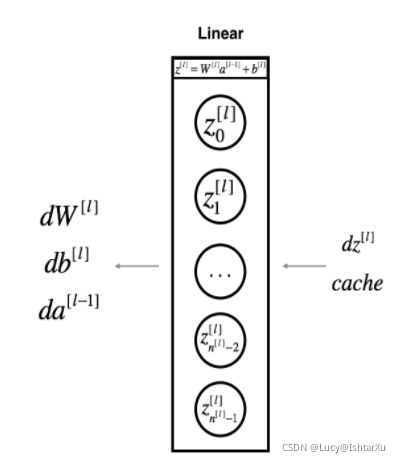
这三个输出
(
d
W
[
l
]
,
d
b
[
l
]
,
d
A
[
l
]
)
(dW^{[l]}, db^{[l]}, dA^{[l]})
(dW[l],db[l],dA[l]) 使用
d
Z
[
l
]
dZ^{[l]}
dZ[l]计算.这些是你需要的公式:
d
W
[
l
]
=
?
L
?
W
[
l
]
=
1
m
d
Z
[
l
]
A
[
l
?
1
]
T
(8)
dW^{[l]} = \frac{\partial \mathcal{L} }{\partial W^{[l]}} = \frac{1}{m} dZ^{[l]} A^{[l-1] T} \tag{8}
dW[l]=?W[l]?L?=m1?dZ[l]A[l?1]T(8)
d
b
[
l
]
=
?
L
?
b
[
l
]
=
1
m
∑
i
=
1
m
d
Z
[
l
]
(
i
)
(9)
db^{[l]} = \frac{\partial \mathcal{L} }{\partial b^{[l]}} = \frac{1}{m} \sum_{i = 1}^{m} dZ^{[l](i)}\tag{9}
db[l]=?b[l]?L?=m1?i=1∑m?dZ[l](i)(9)
d
A
[
l
?
1
]
=
?
L
?
A
[
l
?
1
]
=
W
[
l
]
T
d
Z
[
l
]
(10)
dA^{[l-1]} = \frac{\partial \mathcal{L} }{\partial A^{[l-1]}} = W^{[l] T} dZ^{[l]} \tag{10}
dA[l?1]=?A[l?1]?L?=W[l]TdZ[l](10)
【练习】:使用上面的 3 个公式来实现 linear_backward()。
# GRADED FUNCTION: linear_backward
def linear_backward(dZ, cache):
"""
Implement the linear portion of backward propagation for a single layer (layer l)
Arguments:
dZ -- Gradient of the cost with respect to the linear output (of current layer l)
cache -- tuple of values (A_prev, W, b) coming from the forward propagation in the current layer
Returns:
dA_prev -- Gradient of the cost with respect to the activation (of the previous layer l-1), same shape as A_prev
dW -- Gradient of the cost with respect to W (current layer l), same shape as W
db -- Gradient of the cost with respect to b (current layer l), same shape as b
"""
A_prev, W, b = cache
m = A_prev.shape[1]
### START CODE HERE ### (≈ 3 lines of code)
dW = 1/m * np.dot(dZ, A_prev.T)
db = 1/m * np.sum(dZ, axis=1, keepdims=True)
dA_prev = np.dot(W.T,dZ)
### END CODE HERE ###
assert (dA_prev.shape == A_prev.shape)
assert (dW.shape == W.shape)
assert (db.shape == b.shape)
return dA_prev, dW, db
测试代码
# Set up some test inputs
dZ, linear_cache = linear_backward_test_case()
dA_prev, dW, db = linear_backward(dZ, linear_cache)
print ("dA_prev = "+ str(dA_prev))
print ("dW = " + str(dW))
print ("db = " + str(db))

6.2 - 反向线性激活
接下来,您将创建一个合并两个辅助函数的函数:linear_backward 和激活的反向传播linear_activation_backward。
为了帮助您实现 linear_activation_backward,我们提供了两个反向函数:
sigmoid_backward:实现 SIGMOID 单元的反向传播。 您可以按如下方式调用它:
dZ = sigmoid_backward(dA, activation_cache)
relu_backward:实现 RELU 单元的反向传播。 您可以按如下方式调用它:
dZ = relu_backward(dA, activation_cache)
如果 𝑔(.)是激活函数,sigmoid_backward 和 relu_backward 计算
d
Z
[
l
]
=
d
A
[
l
]
?
g
′
(
Z
[
l
]
)
(11)
dZ^{[l]} = dA^{[l]} * g'(Z^{[l]}) \tag{11}
dZ[l]=dA[l]?g′(Z[l])(11)
【练习】:为 LINEAR->ACTIVATION 层实现反向传播。
# GRADED FUNCTION: linear_activation_backward
def linear_activation_backward(dA, cache, activation):
"""
实现 LINEAR->ACTIVATION 层的反向传播.
参数:
dA -- post-activation gradient for current layer l
cache -- tuple of values (linear_cache, activation_cache) we store for computing backward propagation efficiently
activation -- the activation to be used in this layer, stored as a text string: "sigmoid" or "relu"
Returns:
dA_prev -- Gradient of the cost with respect to the activation (of the previous layer l-1), same shape as A_prev
dW -- Gradient of the cost with respect to W (current layer l), same shape as W
db -- Gradient of the cost with respect to b (current layer l), same shape as b
"""
linear_cache, activation_cache = cache
if activation == "relu":
### START CODE HERE ### (≈ 2 lines of code)
dZ = relu_backward(dA, activation_cache)
dA_prev, dW, db = linear_backward(dZ, linear_cache)
### END CODE HERE ###
elif activation == "sigmoid":
### START CODE HERE ### (≈ 2 lines of code)
dZ = sigmoid_backward(dA, activation_cache)
dA_prev, dW, db = linear_backward(dZ, linear_cache)
### END CODE HERE ###
return dA_prev, dW, db
测试代码
AL, linear_activation_cache = linear_activation_backward_test_case()
dA_prev, dW, db = linear_activation_backward(AL, linear_activation_cache, activation = "sigmoid")
print ("sigmoid:")
print ("dA_prev = "+ str(dA_prev))
print ("dW = " + str(dW))
print ("db = " + str(db) + "\n")
dA_prev, dW, db = linear_activation_backward(AL, linear_activation_cache, activation = "relu")
print ("relu:")
print ("dA_prev = "+ str(dA_prev))
print ("dW = " + str(dW))
print ("db = " + str(db))
输出结果
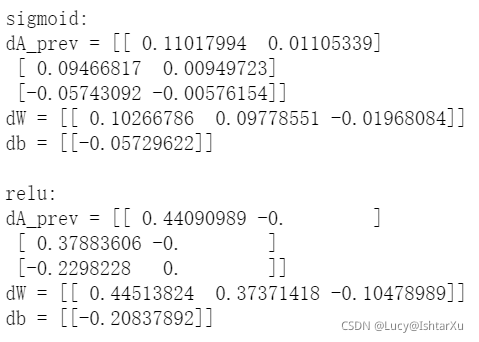
6.3 - L 模型反向
现在您将为整个网络实现反向功能。 回想一下,当您实现 L_model_forward 函数时,在每次迭代时,您都存储了一个包含 (X,W,b, 和 z) 的缓存。 在反向传播模块中,您将使用这些变量来计算梯度。 因此,在 L_model_backward 函数中,您将从层 𝐿 开始向后遍历所有隐藏层。 在每个步骤中,您将使用层 𝑙的缓存值通过层 𝑙进行反向传播。 下面的图 5 显示了反向传递。
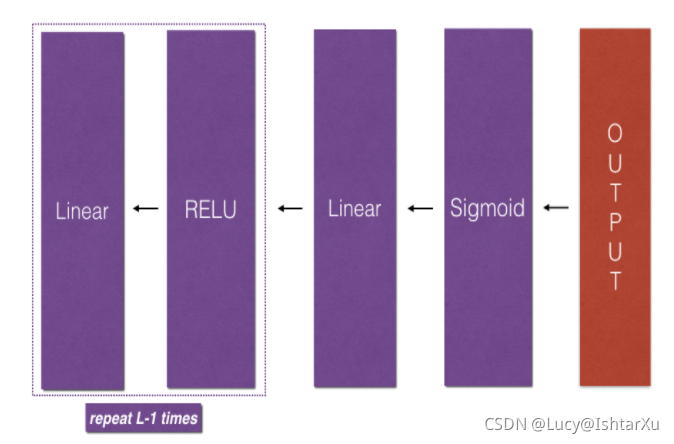
初始化反向传播:为了通过这个网络反向传播,我们知道输出是
A
[
L
]
=
σ
(
Z
[
L
]
)
A^{[L]} = \sigma(Z^{[L]})
A[L]=σ(Z[L])。 因此,您的代码需要计算dAL
=
?
L
?
A
[
L
]
= \frac{\partial \mathcal{L}}{\partial A^{[L]}}
=?A[L]?L?。 为此,请使用以下公式(使用您不需要深入了解的微积分得出):
dAL = - (np.divide(Y, AL) - np.divide(1 - Y, 1 - AL)) # derivative of cost with respect to AL
numpy中的divide函数用法
然后,您可以使用此激活后梯度 dAL 继续向后移动。 如图 5 所示,您现在可以将 dAL 输入到您实现的 LINEAR->SIGMOID 反向函数中(它将使用 L_model_forward 函数存储的缓存值)。 之后,您将必须使用 for 循环使用 LINEAR->RELU 反向函数遍历所有其他层。 您应该将每个 dA、dW 和 db 存储在 grads 字典中。 为此,请使用以下公式:
g
r
a
d
s
[
"
d
W
"
+
s
t
r
(
l
)
]
=
d
W
[
l
]
(15)
grads["dW" + str(l)] = dW^{[l]}\tag{15}
grads["dW"+str(l)]=dW[l](15)
举例, 对于
l
=
3
l=3
l=3 需要存储
d
W
[
l
]
dW^{[l]}
dW[l] 在 grads["dW3"].
【练习】: 实现反向传播[LINEAR->RELU] × \times × (L-1) -> LINEAR -> SIGMOID模型.
# GRADED FUNCTION: L_model_backward
def L_model_backward(AL, Y, caches):
"""
Implement the backward propagation for the [LINEAR->RELU] * (L-1) -> LINEAR -> SIGMOID group
Arguments:
AL -- probability vector, output of the forward propagation (L_model_forward())
Y -- true "label" vector (containing 0 if non-cat, 1 if cat)
caches -- list of caches containing:
every cache of linear_activation_forward() with "relu" (it's caches[l], for l in range(L-1) i.e l = 0...L-2)
the cache of linear_activation_forward() with "sigmoid" (it's caches[L-1])
Returns:
grads -- A dictionary with the gradients
grads["dA" + str(l)] = ...
grads["dW" + str(l)] = ...
grads["db" + str(l)] = ...
"""
grads = {}
L = len(caches) # the number of layers
m = AL.shape[1]
Y = Y.reshape(AL.shape) # after this line, Y is the same shape as AL
# Initializing the backpropagation
### START CODE HERE ### (1 line of code)
dAL = -np.divide(Y, AL) - np.divide(1 - Y, 1 - AL)
### END CODE HERE ###
# Lth layer (SIGMOID -> LINEAR) gradients. Inputs: "AL, Y, caches". Outputs: "grads["dAL"], grads["dWL"], grads["dbL"]
### START CODE HERE ### (approx. 2 lines)
current_cache = caches[L - 1]
grads["dA" + str(L)], grads["dW" + str(L)], grads["db" + str(L)] = linear_activation_backward(dAL, current_cache, activation = 'sigmoid')
### END CODE HERE ###
for l in reversed(range(L - 1)):
# lth layer: (RELU -> LINEAR) gradients.
# Inputs: "grads["dA" + str(l + 2)], caches". Outputs: "grads["dA" + str(l + 1)] , grads["dW" + str(l + 1)] , grads["db" + str(l + 1)]
### START CODE HERE ### (approx. 5 lines)
current_cache = caches[l]
dA_prev_temp, dW_temp, db_temp = linear_activation_backward(grads["dA" + str(l + 2)], current_cache, activation = 'relu')
grads["dA" + str(l + 1)] = dA_prev_temp
grads["dW" + str(l + 1)] = dW_temp
grads["db" + str(l + 1)] = db_temp
### END CODE HERE ###
return grads
测试代码
AL, Y_assess, caches = L_model_backward_test_case()
grads = L_model_backward(AL, Y_assess, caches)
print ("dW1 = "+ str(grads["dW1"]))
print ("db1 = "+ str(grads["db1"]))
print ("dA1 = "+ str(grads["dA1"]))
输出结果
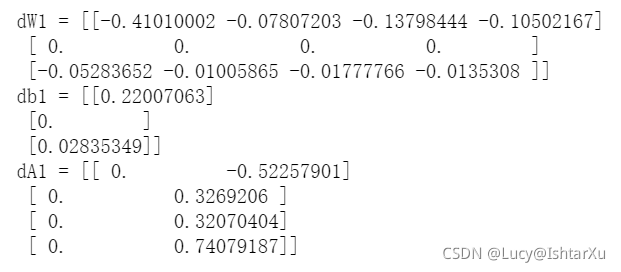
6.4 - 更新参数
在本节中,您将使用梯度下降更新模型的参数:
W
[
l
]
=
W
[
l
]
?
α
?
d
W
[
l
]
(16)
W^{[l]} = W^{[l]} - \alpha \text{ } dW^{[l]} \tag{16}
W[l]=W[l]?α?dW[l](16)
b
[
l
]
=
b
[
l
]
?
α
?
d
b
[
l
]
(17)
b^{[l]} = b^{[l]} - \alpha \text{ } db^{[l]} \tag{17}
b[l]=b[l]?α?db[l](17)
其中 α \alpha α 是学习率。 计算更新后的参数后,将它们存储在参数字典中。
【练习】:实现 update_parameters() 以使用梯度下降更新参数。
【说明】:在每个 𝑊[𝑙]和 𝑏[𝑙]上使用梯度下降更新参数,用于 𝑙=1,2,…,𝐿。
# GRADED FUNCTION: update_parameters
def update_parameters(parameters, grads, learning_rate):
"""
Update parameters using gradient descent
Arguments:
parameters -- python dictionary containing your parameters
grads -- python dictionary containing your gradients, output of L_model_backward
Returns:
parameters -- python dictionary containing your updated parameters
parameters["W" + str(l)] = ...
parameters["b" + str(l)] = ...
"""
L = len(parameters) // 2 # number of layers in the neural network
# Update rule for each parameter. Use a for loop.
### START CODE HERE ### (≈ 3 lines of code)
for l in range(L):
parameters["W" + str(l+1)] = parameters["W" + str(l + 1)] - learning_rate * grads["dW" + str(l+1)]
parameters["b" + str(l+1)] = parameters["b" + str(l+1)] - learning_rate * grads["db" + str(l+1)]
### END CODE HERE ###
return parameters
测试代码
parameters, grads = update_parameters_test_case()
parameters = update_parameters(parameters, grads, 0.1)
print ("W1 = "+ str(parameters["W1"]))
print ("b1 = "+ str(parameters["b1"]))
print ("W2 = "+ str(parameters["W2"]))
print ("b2 = "+ str(parameters["b2"]))
输出结果
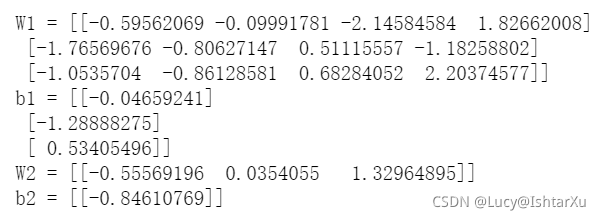
7 - 结论
恭喜您实现了构建深度神经网络所需的所有功能!
我们知道这是一项漫长的任务,但未来只会变得更好。 作业的下一部分更容易。
在下一个作业中,您将把所有这些放在一起构建两个模型:
- 一个两层神经网络
- 一个 L 层神经网络
实际上,您将使用这些模型对猫与非猫图像进行分类!